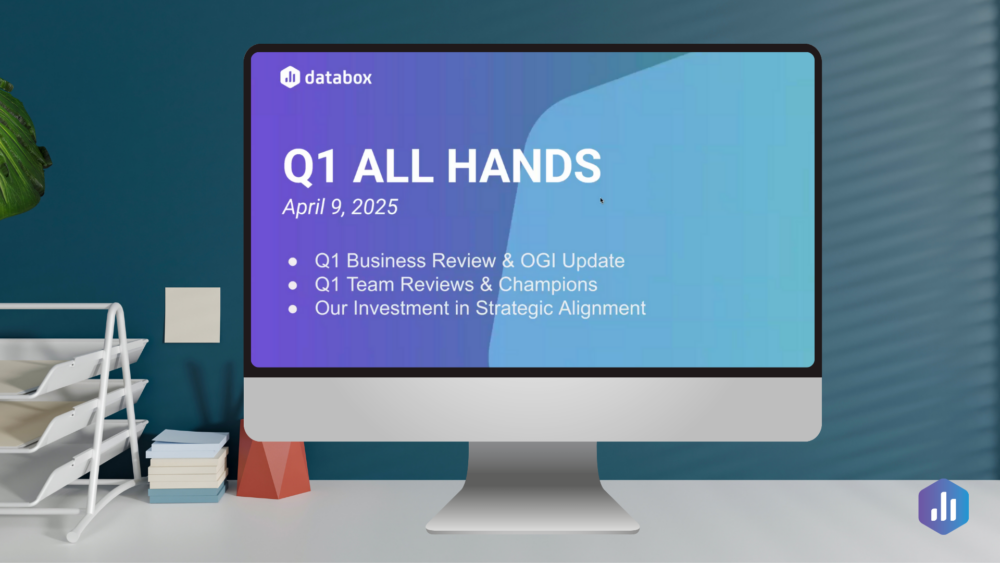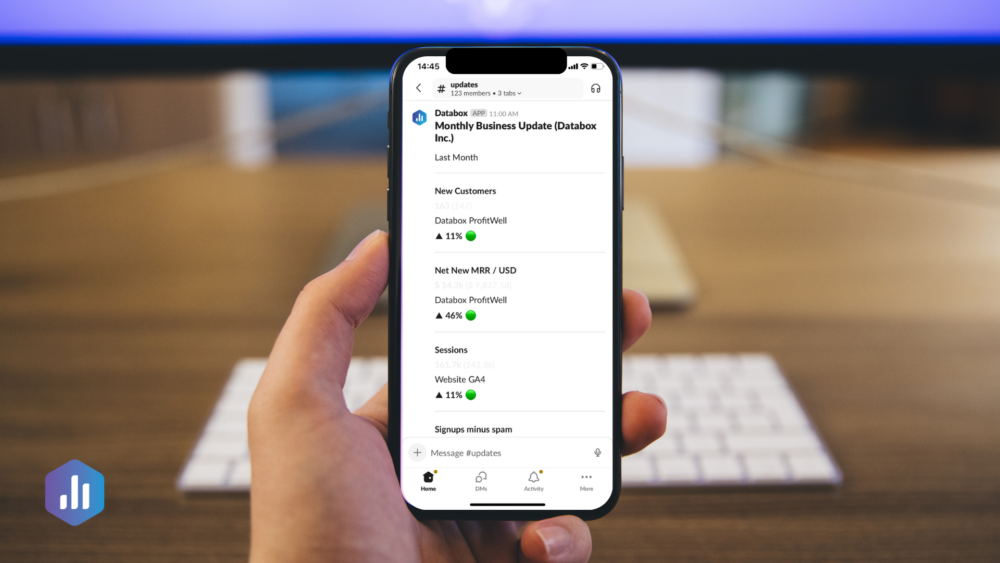Table of contents
At Databox, we talk a lot about accountability, team alignment, and empowerment. But one principle makes all of that possible: transparency.
And when we say transparency, we mean it.
Every team member has access to the same data as our executive team, from company-wide KPIs to our bank balance.
Why?
Because when people understand the big picture, they are more motivated to do their best work and contribute meaningfully.
Keep reading to learn about
- how we practice transparency,
- where it came from, and
- the impact it’s had on our team and business.
What We Mean by Transparency
At Databox, transparency means sharing the right data with the right people, in real time, with the context needed to understand it.
That includes:
- performance metrics,
- strategic priorities,
- quarterly team plans,
- financial status,
- progress toward company-wide goals,
- … and more.
Transparency is not flooding people with dashboards or spreadsheets.
It means providing the context they need in order to make better decisions and ultimately be better in their roles.
And yes, it also means being open when results are not what we have hoped for. It has helped us build a culture of study and inclusivity instead of insecurity and fear.
Why It Matters So Much
We made a decision years ago to share information openly within our organization and never to silo it at the leadership level.
Our logic was simple: people can’t take ownership of their work if they don’t understand how it connects to the bigger picture.As our founder, Davorin Gabrovec, explains:
“Building a startup is hard. What matters is that your team is with you, not behind you.”
From the early days of Databox, Davorin believed that transparency is not just a leadership style, but something that is necessary in order to create a strong team that will have your back.

That mindset turned into a habit and, over time, became an integral part of our culture.
Transparency at Databox is not just for show. It serves us well. It builds trust, keeps us on the same page, and helps us move forward together.
And since we’re in the business of helping companies use data to improve performance, sharing our data internally is second nature.
Besides, it motivates people and shows them exactly how their efforts contribute to the bigger goals we are chasing as a company together.
How We Practice Transparency
By now, being transparent has become our second nature, so we practice it organically. Here are some of the everyday ways we keep it alive:
All-Hands Meetings
Each quarter, we hold a company-wide meeting to share progress toward goals, financial updates (yes, that includes our bank balance), lessons learned, and strategic priorities. It’s a chance to align across teams and give everyone deeper context on where we’re headed—and why.

Company Dashboards
What kind of business analytics company would we be if we wouldn’t use our own product?
So, normally, we use Databox to track everything from revenue and marketing performance to support response times. All dashboards are accessible through our shared company account, so anyone can log in and get a quick snapshot of how we’re doing, anytime.
🎯 Want to see how we structure team-wide transparency? 👉Browse pre-made performance templates here
Automatic Slack Updates
We use bots and integrations to regularly share key updates via Slack — from revenue metrics to product adoption stats. This keeps our metrics visible without needing to hunt them down. Besides getting weekly automatic updates on our main KPIs, we also make sure to keep everyone in the loop by posting major changes, updates, wins and events on there and keep our team informed.

Quarterly Team Plans
Every quarter, each team prepares a short quarterly plan that is shared on our internal company blog and available for everyone to read to get a better understanding of what other teams have in store and how our product will change over time.
Because we are so transparent, and everyone in the company is so informed of our strategy, almost every person in every team is involved in setting these plans. Everyone in the management team also reviews every plan to make sure we’re all aligned. Therefore, when the plans are published on our internal blog, there are no surprises.
OGIs
Our Objectives, Goals and Initiatives (we call them OGIs) are open and tracked publicly in Asana. Each team shares updates, flags roadblocks, and highlights progress regularly. This transparency shows how individual projects ladder up to company goals and our annual target.
By having everyone on board with our company objectives, we allow people to see how they contribute to our objectives and how their projects feed into the bigger picture and help move our business forward.
Cash Flow Transparency
We also share our cash flow openly. Why? Because understanding the real-time health of the business helps our team make more informed decisions and understand the “why” behind big company moves.
These practices only work because we pair transparency with context. Without it, visibility becomes noise.
Context is what makes Transparency Work

Transparency sounds great, but it does require smart leadership. Sharing any numbers without context can create confusion, so when we share numbers, results and any information, we always make sure to share context as well, so people can cut through the noise and really understand what is happening.
That is why we encourage our leaders to:
- Lead with clarity, not control
- Provide ongoing context
- Make education part of the process
- Use transparency to build trust, not fear
The key is not just to show dashboards, but to teach people how to interpret them — and to empower them to act.
The Business Impact of Transparency
In a recent survey we completed of 70+ companies, 74% said transparency improves performance. But only 55% said the upside outweighs the risk. That gap? It comes down to leadership.

Source: Let’s talk transparency by Pete Caputa
Most leaders agree that transparency works, but many still hesitate. Most leaders know transparency works, yet are hesitant to embrace it fully. The reason is often the fear that their team won’t understand the numbers or that bad results might have a negative impact on morale.
But in our experience, the opposite is true.
So what has transparency actually done for us?
According to our internal surveys and what we hear in feedback sessions, here are some of the biggest benefits:
- Better alignment across teams
By staying on top of team goals and plans, teams have a better understanding of other teams’ focus and a greater opportunity to connect and collaborate and create something awesome together. - Faster, more informed decision-making
We don’t like wasting time. By having information available to anyone not only helps us all make data-based decisions, but it speeds up the process significantly too. - Increased ownership and accountability
Teams are accountable for their results and we also make sure to show appreciation and recognition to publicly celebrate successes and champions, which boosts morale and has a positive impact on motivation. - Stronger engagement and morale
People are more motivated because they see how their contributions impact on our company goals, which keeps them engaged and involved.
Not sure if that’s true? Watch our DBUG Session: Does Data Transparency Drive Performance?
The Leadership Challenge (and Opportunity)
Transparency isn’t just a leadership philosophy — our team genuinely appreciates it. As Fedor, one of our Partnership Managers, shared:
“In my previous roles, I often felt in the dark. I never fully understood how my work contributed to the company’s goals… Then, I joined Databox, and I was in a meeting where we were sharing everything — KPIs, team performance, even our bank balance. I couldn’t believe it. Fast forward 3.5 years, and this hasn’t changed. If I were to start my own company, I’d do this from day 1.”
This kind of reaction is common, especially for team members coming from more traditional companies. When people see how their work impacts the bigger picture, they don’t just perform better — they feel more connected and motivated.
Final Thoughts
We’re not the only ones who’ve seen the power of transparency firsthand.
Our CEO spent 9 years at HubSpot, a company well known for its “Culture Code” that includes transparency as a core value. Like we do, they share strategy updates, financials, and goals across all levels. HubSpot’s founder, Dharmesh Shah, was inspired to bake transparency into HubSpot’s culture by many of the principles Netflix shared in their Culture deck and from what he learned directly from Patty McCord, Netflix’s Chief Talent Officer.
Buffer has been leading the way for years as well, openly sharing everything from salaries to company strategy, and their story is a great example of how openness can shape a stronger, more trusting culture.
By now, transparency is engraved into our culture because we believe it’s the best way to build trust, drive performance, and support our people. It helps us live our values, which include Be Accountable, Play as a Team, and Prioritize Customer Impact.
We are far from having everything figured out, but are staying committed to sharing, learning, and empowering our team. Curious about what it’s like to work at a place where nothing’s hidden behind closed doors? Check out our open roles here.












